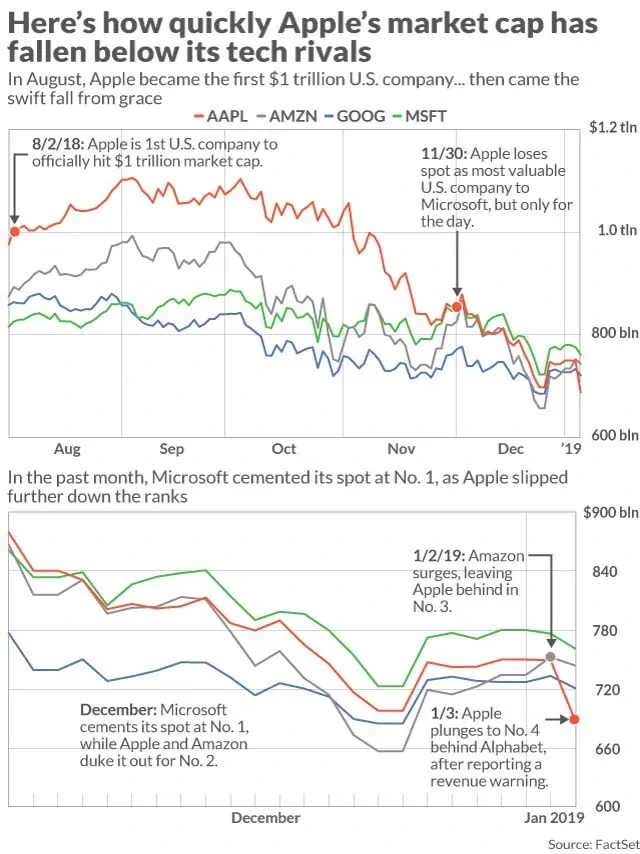Apple is Doomed (Again!)

It is now obvious (in hindsight’s what’s not?) that the iPhone both reached a plateau in term of units penetration, but also price point. Don’t expect to see in 2019 +30% growth in iPhone penetration in US or EU compounded by unit’s price reaching 2,000 USD / EUR.

Tim COOK more then ever is clearly happy to point out that moving forward as a service platform leveraging their user base is the next step. It will just have to “accelerate”:
Our non-iPhone businesses have less exposure to emerging markets, and the vast majority of Services revenue is related to the size of the installed base, not current period sales. Services generated over $10.8 billion in revenue during the quarter, growing to a new quarterly record in every geographic segment, and we are on track to achieve our goal of doubling the size of this business from 2016 to 2020. Our results in China include a new record for Services revenue, and our installed base of devices grew over the last year.Tim COOK, Jan. 2018
In 2014, I was already making the case that Apple didn’t sell ‘products’ anymore and that they were going in AaaS mode (Apple as a Service). I was a tad optimistic at the time. What I underestimated like everyone else, was how Apple would manage to maintain sky-high prices for five consecutive generations of iPhones world-wide (China included).
This strategy is now a good news / bad news scenario for Apple.
Good news is that they have in their DNA this history of bending the music industry to their will, allowing the market to consume music not through plastic CDs anymore, but through 0.99 cents digital bites. They were also masterful at burying everyone in the mobile industry for more then 10 years by making the iOS development platform and the App Store, the most profitable in the market (remember that with only 10-20% of market penetration in mobile phones, they still harvest 90% of the profits in the market).
Bad news? Their DNA is more on the hardware than the service side. Just consider how ridiculously powerful the iPad has become, while iOS still lags behind at delivering best-in class tools and softwares. Or consider how unsatisfying iCloud has been since its inception.
But most importantly, some of their most powerful service bricks such as Apple Pay have been very slowly ramped up worldwide (a handful of EU countries and banks can use the service with no obvious reason to why). Ironically enough, Apple Pay should be the perfect counter-measure to Apple’s Wechat problem in China! (Furthermore, if you read me, you know that the payment brick is for me one of the most critical in digital service businesses.)
So, if you want a new year’s prediction for 2019 I would say that: to know if Apple is doomed, monitor where Apple Pay, it will be the biggest tell to know how fast they will escape the hardware zone.
EDIT – Jan. 5, 2019
pic.twitter.com/8jjiBSEu7zJanuary 4, 2019
Is Apple starting to get out of the comfy zone and dive back in the arena, telling customers (and competitors) what is their added value? Saying that to the CES crowd, while still not attending this non-sensical event where people try to market connected microwaves ovens with 8K screen, is quite something. Exciting times.
EDIT – Jan. 6, 2019
https://t.co/m38bPI1zZtpic.twitter.com/YLRPcJciIxJanuary 6, 2019
And now Apple starts to untighten it’s control on iTunes to let it be used on Samsung TVs. Not that shocking given that iTunes has been already available on Windows for quite a long time now, but possibly a slippery slope. Let’s see where this goes from there.



